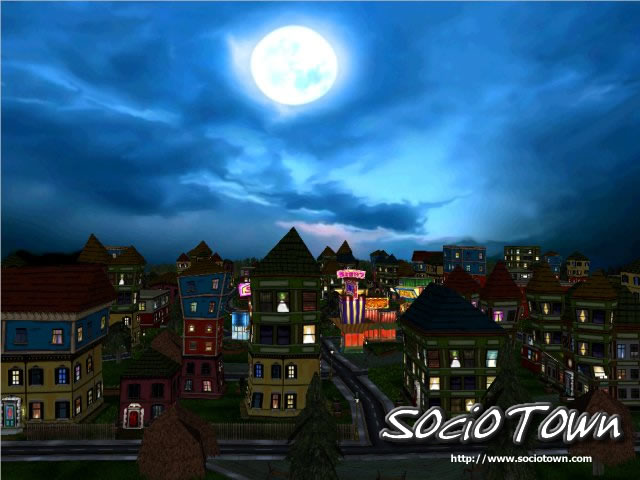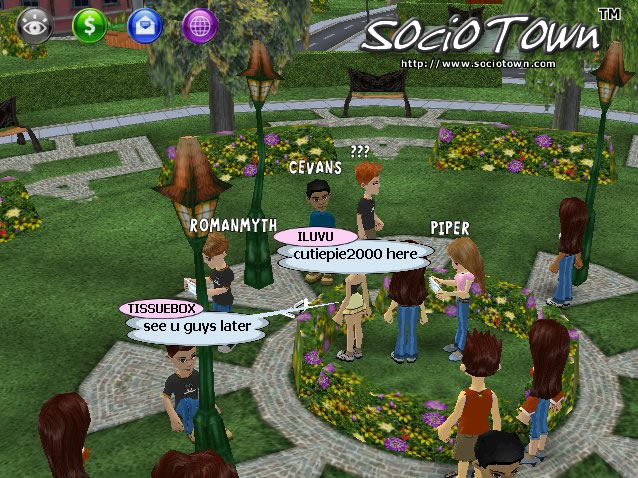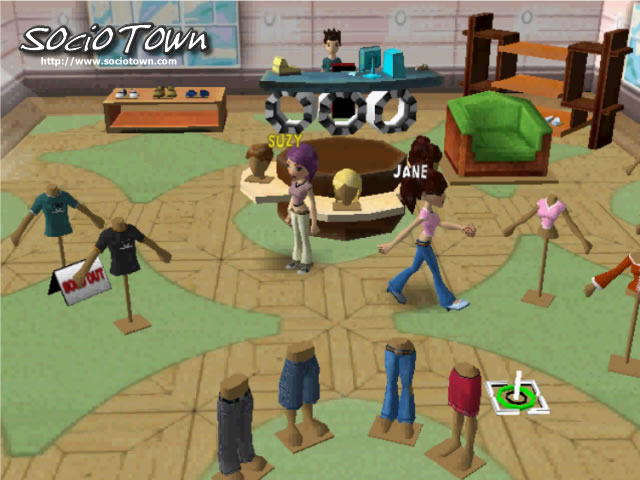After the successful Pow Pow's Mini-Golf which had a multiplayer online mode and the unreleased CityScape Battle, which was going to be a MMO shoot'em up, we felt we were ready to do a full-scale social virtual world.
However in late 2006, I had to make decision on which project to green light. Around this time I working on Pow Pow's Mini-Golf Adventures and CityScape Battle. Mini-Golf Adventure was going to be a desktop game and sequel to the browser-based Pow Pow's Mini-Golf. Earlier in the year, I had spent around 6 months working on CityScape Battle. It already had a working virtual room lobby system and basic battle mode (which can be seen in the preview trailer). CityScape Battle was definitely pretty far along and was already generating a good amount of interest from players.
But I also wanted to experiment with a hybrid business model of advertisements, subscription model, and micro/game transactions. Of course nowadays micro-transactions and subscriptions are nearly ubiquitous with video games and apps. But in the early/mid 2000s, only web games had advertisements, only the big MMORPGs had subscriptions, and micro-transactions were almost non-existent. By this point we had released Pow Pow's Great Adventure, Pow Pow's Puzzle Attack, Pow Pow's Mini-Golf and BlockHeads Clash. With all those games either we struggled to get enough exposure to achieve a good volume of sales or when we did have strong sales, they would drop off pretty quickly.
So I wanted to come up with a business model that would allow us generate income from a relatively small but loyal audience over the long-term. I would use the “Free to Play” with advertising to help cover costs with free players. At the time, only Korean MMORPGs were using the “Free to Play” model. All the US-based MMOs had subscriptions. But I still would use subscriptions to provide relatively reliable and predictable income. And finally I would use micro-transactions/game currency to help get a good return on adding new content. At the time, the only popular virtual chat world using micro-transactions was Habbo Hotel but hadn't been used much with regular games. So I was going to leverage all these revenue models with SocioTown MMO. Ultimately this was the reason why I chose to proceed with development on SocioTown over CityScape Battle. With CityScape Battle I didn't think it would be able to properly utilize micro-transactions or subscriptions in a way that would make sense or would be appealing.
So in 2007, development on SocioTown began in earnest. Originally it was actually called “SocioCity”. But after awhile, I could tell it was going to be tough dealing with size and scope of a big city virtual world, so I felt it would be better to start smaller (hence, SocioTown). Then maybe down the line perhaps with a sequel I would do “SocioCity”.
One of the big goals I had for SocioTown is that I didn't want it to feel just like a collection of disconnected chat rooms with avatars just teleporting in and out constantly. There were already dozens of those type of chat worlds. Even though I didn't have the resources to create a full featured 100-hour MMORPG, I did want SocioTown to feel closer to a Massive Multiplayer Online Game (MMOG) rather than a giant chat room. So I made the decision early on that there would be no teleportation in SocioTown. If you didn't spawn there, then you would have to walk there to get to a particular location. This way if players were walking to the store, they would see other players also walking around town and it just made the town and the world overall seem alive.
Players would also be able to own apartments. While you could spawn in an apartment after the initial login, you couldn't just teleport to people's apartments. You'd have to walk into the apartment building, take the elevator, and goto the appropriate floor. It might sound a little tedious, but again it made SocioTown feel like an actual place and not just a bunch of chat rooms. From a design perspective, it also helped make our relatively small town feel much bigger. I see a lot of big AAA video game developers spend literally millions of dollars crafting beautiful large worlds but they allow the player to teleport or fast travel almost immediately once they reach a checkpoint. This makes their big beautiful world seem much smaller and 90% of the players never interact with or experience much of the game content. The big studios can afford to throw tons and tons of unused content at players, but it really is inefficient game design. As an indie developer, I have to maximize the content I have.
After over a year of intense development, SocioTown was released in March 2008. We had done a few preview trailers and built up an email list, so SocioTown managed to gain some decent activity after just a couple of months. In terms of game progression features, the game was still pretty bare, so I would continue adding new features over the months and then years. Initially there were no jobs. Then they were jobs, but they were non-interactive jobs. Then we had actual interactive jobs and eventually multi-user jobs where players could work at a job during the same time as their friends to make it easier. We also new regions, vehicles, advanced apartment customization, and more.
SocioTown was at its peak from 2009 – 2013. Things began to slow down some in 2014 and in 2015 with Google Chrome killing support for Adobe Shockwave (which SocioTown was based on), that pretty much killed any chance for SocioTown to make a resurgence in its current form. Browser-based games that utilized 3rd party plugins like Shockwave were on death-row. The major web browsers (Google, Firefox, and etc) started pushing HTML5 and began depreciating web plugins. So in 2015 after over 8 years of active development, we stopped development on SocioTown.
SocioTown as of this writing is still up into 2018. There's not much activity anymore because now fewer than 10% of web browsers can play Adobe Shockwave content without modifying the browser. But I just don't have the heart yet to pull the plug. Sometime this year after SocioTown officially reaches 10 years old, I'll probably create a video commentary and then maybe pull the plug after that. A lot also depends if the server resources are needed for the newer games.


